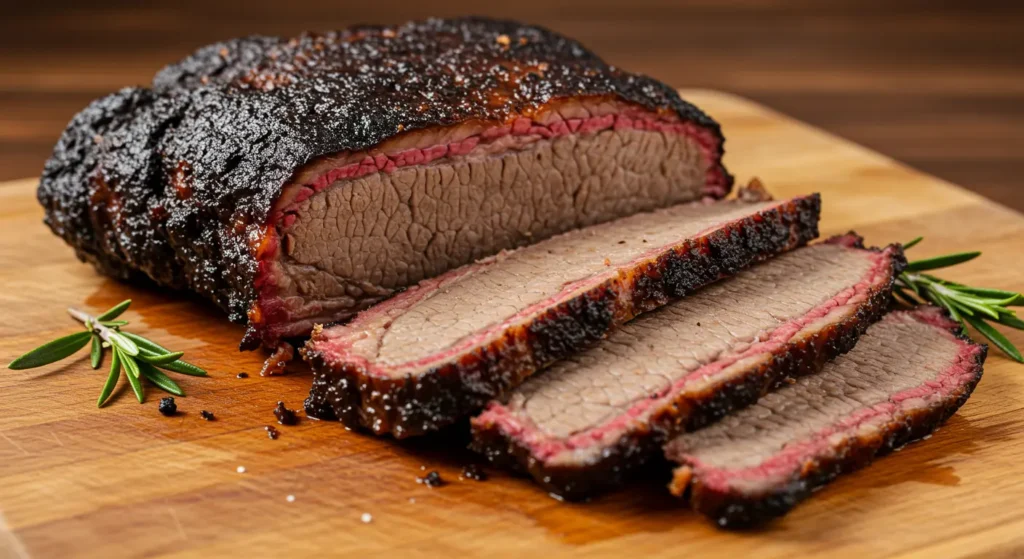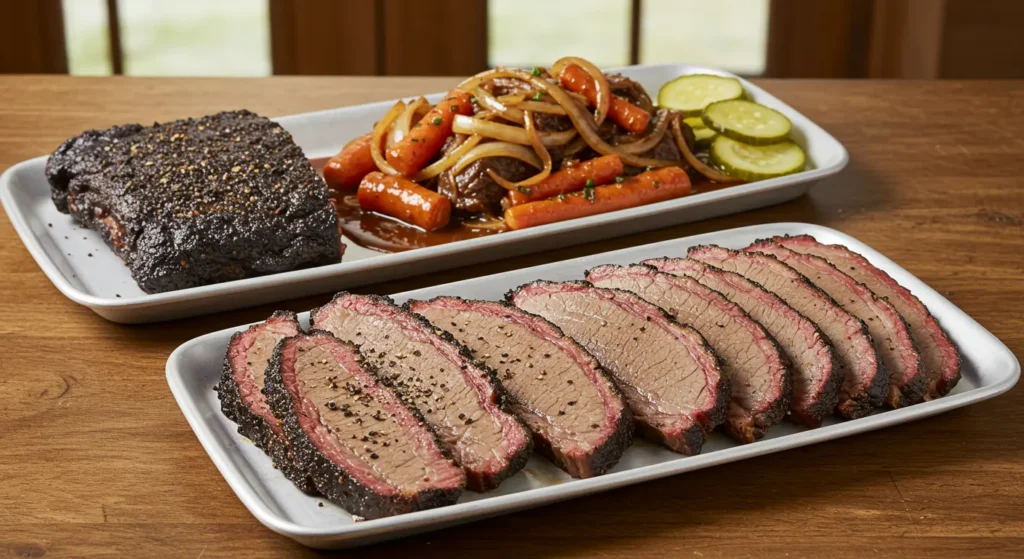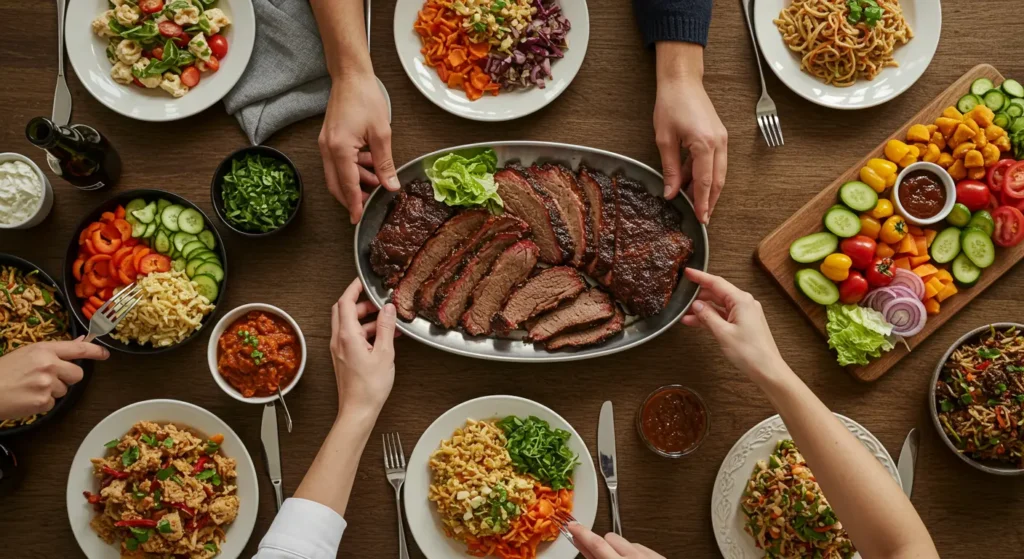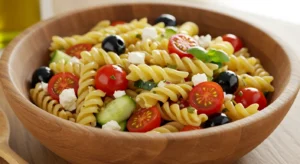Is Brisket Healthy – Why This Recipe?
As Chef Greeny, I’m often asked “is brisket healthy?” when readers discover my passion for this magnificent cut of meat. My journey exploring whether is brisket healthy began during my culinary training when I was astounded by how a tough, seemingly unforgiving piece of beef could transform into something so tender and flavorful with the right technique and patience.
The first time I prepared brisket was for a family gathering where everyone was conscious about their diet and wondering if brisket healthy eating was possible. I was nervous, knowing that this cut demands respect and time. After hours of slow cooking, the moment of truth arrived as I sliced into the meat. The collective “mmm” from my family told me everything I needed to know – I was hooked on brisket from that moment forward, and determined to explore the question: is brisket healthy when prepared thoughtfully?
What makes brisket particularly special to me is its democratic nature. It’s historically been an affordable cut that working-class families could transform into something extraordinary. There’s something beautiful about a dish that doesn’t require luxury ingredients to deliver exceptional results, while still letting us ask: is brisket healthy enough for regular consumption?
In this post, I’ll share my favorite brisket recipe, complete with a health-conscious twist that maintains all the flavor while being mindful of nutritional considerations. You’ll learn about brisket’s surprising health benefits, how to prepare it to perfection, and various ways to enjoy this versatile cut without compromising your dietary goals. By the end, you’ll have a clear answer to the question: is brisket healthy as part of a balanced diet?
Is Brisket Healthy – Ingredients and Preparation
When considering is brisket healthy, the ingredients and preparation methods make all the difference. Here’s how to prepare brisket in a health-conscious way:
Ingredients List
For a health-conscious brisket that serves 8-10 people:
- 5-pound beef brisket, preferably grass-fed
- 2 tablespoons olive oil
- 3 tablespoons low-sodium seasoning rub (combination of paprika, garlic powder, onion powder, black pepper, and a small amount of salt)
- 2 large onions, sliced
- 4 carrots, chopped
- 4 celery stalks, chopped
- 6 garlic cloves, minced
- 2 cups low-sodium beef broth
- 1 cup tomato paste (no added sugar)
- 2 tablespoons apple cider vinegar
- 1 tablespoon Worcestershire sauce
- 2 bay leaves
- 1 tablespoon fresh thyme
- 1 tablespoon fresh rosemary
Substitutions:
- For gluten-free: Ensure your beef broth and Worcestershire sauce are certified gluten-free
- For lower carbs: Replace carrots with turnips or radishes
- For nightshade-free: Omit tomato paste and paprika, substitute with 1 cup beef bone broth and 1 tablespoon maple syrup
Step-by-Step Instructions
- Trim the brisket – Remove excess fat, but leave about 1/4 inch fat cap for flavor and moisture. This step is crucial for answering “is brisket healthy” positively, as it significantly reduces the total fat content while maintaining juiciness.
- Prepare the rub – Mix the seasoning ingredients thoroughly. Using low-sodium options helps control the salt content, making this brisket more heart-friendly when asking is brisket healthy for those with cardiovascular concerns.
- Season the meat – Apply olive oil to all sides of the brisket, then coat thoroughly with the seasoning rub. Allow the seasoned meat to rest at room temperature for 1 hour, which helps the meat cook more evenly.
- Preheat your cooking method – For oven, preheat to 275°F. For smoker, prepare for 225-250°F with indirect heat.
- Prepare the cooking vessel – In a large roasting pan or Dutch oven, arrange the chopped vegetables to create a bed for the brisket.
- Sear the brisket – In a large skillet over medium-high heat, briefly sear each side of the brisket for 2-3 minutes to develop flavor compounds that enhance the taste without adding calories.
- Position the brisket – Place the seared brisket on top of the vegetable bed, fat cap up.
- Prepare the liquid – Mix the beef broth, tomato paste, apple cider vinegar, and Worcestershire sauce. Pour around (not over) the brisket.
- Add aromatics – Distribute garlic, bay leaves, thyme, and rosemary around the brisket.
- Cover and cook – Tightly cover with foil or a lid. For oven method, cook for approximately 1 hour per pound (about 5 hours for a 5-pound brisket). For smoker, plan on 1.5 hours per pound.
- Check for doneness – The brisket is ready when it reaches an internal temperature of 195-205°F and a probe slides into the meat with minimal resistance.
- Rest the meat – Allow the brisket to rest, still covered, for at least 30 minutes before slicing. This redistribution of juices is critical for both texture and nutrient retention.
- Slice against the grain – Cut perpendicular to the visible muscle fibers to ensure tender bites.
Notes and Tips
- Storage: Refrigerate leftover brisket for up to 4 days in an airtight container. The flavor often improves on day two!
- Freezing: Slice and portion cooled brisket, then freeze in airtight containers for up to 3 months. Thaw overnight in the refrigerator before reheating.
- Reheating: To maintain moisture, reheat sliced brisket in a covered dish with a splash of beef broth at 300°F until warmed through (about 20 minutes).
- Make-ahead: Brisket actually benefits from being made 1-2 days ahead. Cook completely, refrigerate whole, then slice and reheat when ready to serve.
- Portion control: When considering is brisket healthy as part of your diet, remember that a healthy serving size is about 3-4 ounces of cooked brisket. Pair with plenty of vegetables to round out your meal.
Is Brisket Healthy – Nutritional Information
To properly answer “is brisket healthy,” we need to examine its nutritional profile:
Nutrition Facts (Per Serving – 4 oz portion)
- Calories: (~250)
- Carbohydrates: (3g)
- Protein: (28g)
- Total Fat: (15g)
- Saturated Fat: (5g)
- Unsaturated Fat: (9g)
- Trans Fat: (0g)
- Fiber: (0.5g)
- Sugar: (1g)
- Cholesterol: (75mg)
- Sodium: (310mg)
- Iron: (3mg)
- Zinc: (7mg)
- B vitamins: High in B12, B6, niacin, and riboflavin
Chef’s Note: These nutritional values can vary based on the specific cut of brisket, trimming level, and cooking method. When evaluating is brisket healthy, consider that grass-fed brisket typically contains more omega-3 fatty acids and less total fat than conventional beef.
Is Brisket Healthy – Health Considerations
When people ask “is brisket healthy,” the answer depends on preparation and consumption patterns. When prepared thoughtfully, brisket can be part of a balanced diet. Here are some health aspects to consider:
| Health Aspect | Details |
|---|---|
| Protein Content | Brisket is an excellent source of complete protein, providing all essential amino acids |
| Fat Profile | When asking is brisket healthy, remember that trimming before cooking can significantly reduce fat content |
| Micronutrients | Rich in iron, zinc, and B vitamins, particularly B12, which supports neurological function |
| Sodium Levels | Using low-sodium seasonings helps make brisket heart-healthier |
| Cooking Method | Slow cooking breaks down tough fibers, making nutrients more bioavailable |
So, is brisket healthy compared to other protein sources? It contains more fat than chicken breast or fish, but offers excellent nutrient density and can be part of a health-conscious diet when prepared properly and consumed in moderation.
Is Brisket Healthy – History and Cultural Significance
While exploring is brisket healthy from a nutritional perspective, we should also appreciate its rich cultural heritage that spans continents and centuries. This humble cut of meat has been central to many cultural traditions, particularly in Jewish, Southern American, and Central European cuisines.
In Jewish cooking, brisket holds special significance as a centerpiece for holiday meals, particularly during Passover and Rosh Hashanah. The tradition of slow-cooking tough cuts of meat emerged from both economic necessity and religious dietary laws. Brisket was an affordable option that, with proper cooking, could feed an entire family for a celebration.
In Texas, brisket became the cornerstone of barbecue tradition. German and Czech immigrants who settled in Central Texas in the 19th century brought their meat-smoking techniques, applying them to available local cuts. Butcher shops would smoke leftover meat to preserve it, eventually leading to the development of the Texas barbecue traditions we know today.
The nutritional approach to brisket has evolved over time. What was once valued primarily for its affordability is now appreciated for its protein content and nutrient density. When people ask “is brisket healthy,” they’re often surprised to learn that modern understanding of nutrition has helped us recognize that when properly prepared, brisket can be part of a wholesome diet.
Regional variations abound:
- Texas-style: Typically seasoned simply with salt and pepper, smoked low and slow
- Kansas City-style: Often incorporates a sweet and tangy sauce
- Jewish-style: Usually braised with vegetables and sweet and sour elements
- Korean: Transformed into Chadolbaegi, thinly sliced and grilled quickly
Each cultural interpretation offers a different answer to “is brisket healthy” with varying levels of added sugars, sodium, and accompanying ingredients affecting the overall nutritional profile.
Is Brisket Healthy – Creative Variations
For those concerned about is brisket healthy enough for their dietary needs, here are health-conscious variations:
Leaner Mediterranean Brisket
This variation improves the “is brisket healthy” equation by reducing fat content while incorporating heart-healthy ingredients:
- Use the leanest brisket you can find, trimming all visible fat
- Replace half the beef broth with red wine (alcohol cooks off, leaving beneficial antioxidants)
- Add 1 cup each of diced tomatoes and bell peppers
- Include 1/4 cup kalamata olives, pitted and chopped
- Season with oregano, thyme, and rosemary
- Finish with fresh lemon zest and parsley
Nutritional benefit: Lower in total fat, higher in antioxidants, and incorporates heart-healthy Mediterranean ingredients.
Low-Carb Smoky Brisket Bowl
Perfect for those asking “is brisket healthy for keto or low-carb diets”:
- Prepare the brisket with a coffee and spice rub (2 tablespoons ground coffee, 1 tablespoon each of paprika, garlic powder, onion powder, and black pepper)
- Smoke or slow-cook until tender
- Serve over cauliflower rice sautéed with ghee and herbs
- Top with sliced avocado, fermented vegetables, and a drizzle of olive oil
Nutritional benefit: Very low in carbohydrates, high in healthy fats, and includes probiotic-rich fermented foods for gut health.
Anti-Inflammatory Turmeric Brisket
For those wondering “is brisket healthy for inflammatory conditions”:
- Add 1 tablespoon fresh grated turmeric and 1 teaspoon black pepper to your rub
- Include 1-inch pieces of fresh ginger in your cooking liquid
- Replace carrots with sweet potatoes and add 1 cup cherry tomatoes
- Finish with a sprinkle of fresh cilantro and a squeeze of lime
Nutritional benefit: Contains curcumin from turmeric and gingerol from ginger, both powerful anti-inflammatory compounds. The black pepper enhances curcumin absorption.
Is Brisket Healthy – Frequently Asked Questions
Is brisket healthy compared to other cuts of beef?
Brisket has both advantages and disadvantages compared to other cuts. It’s higher in collagen, which breaks down into gelatin during cooking, potentially supporting joint health. However, it typically has more fat than leaner cuts like sirloin or tenderloin. The key to making brisket healthier is proper trimming before cooking and portion control when serving.
Is brisket healthy for weight loss diets?
Yes, in moderation. The high protein content of brisket helps promote satiety, keeping you fuller longer. For weight management, stick to 3-4 ounce portions, trim visible fat before cooking, and pair with non-starchy vegetables. Save the fattier point-end for special occasions and opt for the leaner flat-end for regular consumption.
Is brisket healthy when grass-fed versus conventional?
Grass-fed brisket typically contains more omega-3 fatty acids, conjugated linoleic acid (CLA), and antioxidants than grain-fed beef. While still containing saturated fat, the overall fatty acid profile is generally considered more favorable in grass-fed beef. It also tends to be leaner overall, though it may cook slightly differently due to this reduced fat content.
Is brisket healthy when cooked different ways?
Slow cooking methods like braising or using a slow cooker are preferable from a health perspective. These methods allow you to skim off rendered fat during cooking. While smoking imparts excellent flavor, it can add compounds that aren’t ideal for regular consumption. For the healthiest option, pressure cooking brisket allows you to thoroughly cook the meat while retaining nutrients, and makes it easier to remove separated fat.
Is brisket healthy enough to eat regularly?
For most healthy individuals, enjoying brisket 1-2 times per month as part of a balanced diet is reasonable. Those with specific health concerns like heart disease or high cholesterol might want to limit consumption to special occasions. Always pair with plenty of vegetables and consider it an occasional protein rather than a dietary staple.
Is Brisket Healthy – Final Thoughts
So, is brisket healthy? When prepared thoughtfully, brisket can be more than just a delicious indulgence—it can be part of a nutrient-dense, satisfying meal that provides valuable protein, vitamins, and minerals. The key is in the preparation: trimming excess fat, using healthy cooking methods, controlling portions, and balancing your plate with plenty of vegetables.
What makes brisket special is how it brings people together. There’s something magical about a dish that requires patience and care to prepare, that’s designed to be shared among family and friends. Food is not just about nutrition—it’s about connection, tradition, and enjoyment.
Remember that healthy eating is about balance and sustainability. Rather than labeling foods as simply “good” or “bad,” consider how they fit into your overall dietary pattern. Occasional brisket, prepared with health in mind and enjoyed mindfully, can absolutely be part of a nourishing lifestyle.
I encourage you to try my health-conscious brisket recipe and adapt it to suit your personal taste and dietary needs. The versatility of this cut means there’s a brisket variation for almost everyone, and now you can confidently answer “is brisket healthy?” with a nuanced understanding of its nutritional profile.
Have you tried making brisket at home? What’s your favorite way to prepare it? Leave a comment with your favorite variation or any questions you might have about making this classic dish part of your healthy eating plan!







